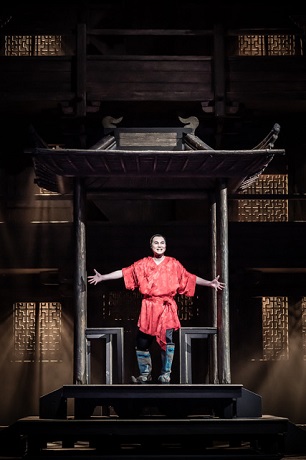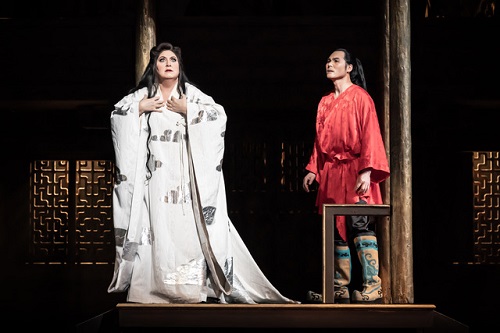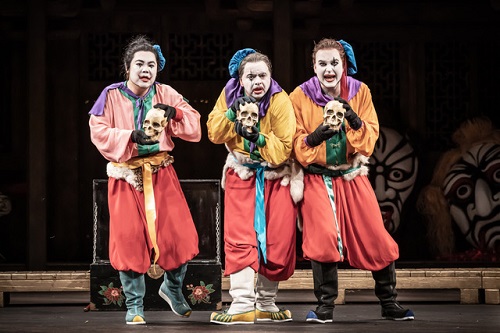Is Turandot the last great Italian opera of the twentieth century? It’s a common and widely written viewpoint – indeed, William Ashbrook and Harold Powers called it ‘the end of the great tradition’. Until Antonio Pappano conducted this performance at Covent Garden, his first in any opera house, one might argue he would never think this was the case. His championing of Luigi Dallapiccola’s Il prigioniero – composed more than twenty years after Turandot – has long been an opera Pappano has performed – as recently as last year in London with the London Symphony Orchestra. His view that it’s one of the great “inquisition” operas, beside Fidelio and Don Carlos, or Blacher’s oratorio The Grand Inquisitor, isn’t going to suddenly reverse this view I imagine.
Ironically, Il prigioniero shares at least one theme, although handled very differently, with Turandot – that of torture, combined with an ecstatic embracing of freedom. Orchestrally, there may be similarities, too, even if Dallapiccola embraced the language of Webern, Berg and Bartók. Both Puccini and Dallapiccola wrote for vast orchestral forces and used them with terrifying power – even Puccini came closer than in any of his previous operas to a discordant explosiveness that is absent from his earlier works. But both, too, would use a vast orchestra with economy – there are moments of tenderness, introspection and beauty in both operas.
Conductors are often helped by the productions they are given and in the case of Pappano he was working with Andrei Serban’s more than four-decade old vision of Turandot in its sixteenth, and final, revival. Like Covent Garden’s magnificent Tosca, of similar vintage, it is a production which mostly lacks controversy because Serban has principally returned to the roots of the play on which Puccini based the opera by Carlo Gozzi in 1762. Gozzi reframed the original Persian story into a fable set in ancient China but in doing so he created a narrative around Italian commedia dell’arte tradition. The most obvious example of this in the opera are the three bureaucratic ministers – Ping, Pang and Pong, officials drawn as figures of comedy but in Serban’s production complicit executioners as opposite values become intertwined.
The production is very much a live action one; rarely does it ever become static. Tiered balconies on the stage are mirrored back into the auditorium; the chorus are spectators looking outwards as the audience become spectators, looking inwards. The story is played out on stage by the singers, dancers, actors and chorus and everything seems to be in continual motion: the procession of the Mandarin as he delivers the proclamation of the oath, the Executioner’s vast slowly turning grindstone, the dragon cart that carries the limp body of the slave-girl Liù, the Emperor’s gilded throne descending on a pillow of clouds.
Unusually, the production opens with us having seen the stage in full view already. Red ribbons of blood hang down, a symbol of the cruelty that runs through both this opera and Serban’s vision of it. The striking boldness of the rich colours stands in contrast to the dark wooden set – just as the costumes do as well. Masks are an important element of this. Part suggestive of Japanese Kabuki, Turandot’s half white mask reflects the two halves of this complex woman, a princess who like her ancestress Lo-u-Ling will never submit to being possessed by any man and who is capable only of iciness; eventually she must yield to love and overcome her inhumanity. But Serban’s masks serve dual purposes. For the dancers and chorus they are both a means to communicate silence and commentary; for the actors like the Prince of Persia and the Executioner they serve to hide emotions and expressions we cannot see but can only imagine.
There is no equivocation when it comes to the larger-than-life sized masks of the slain suitors with their executed heads on pikes streaming blood. Painted garishly in Act I, during the opening scene of Act II with Ping, Pang and Pong singing of the endless round of executions and their desire to retire to the countryside, the masks have rotted to naked grey flesh. Among them is the young Prince of Persia, a mere child whom we saw in Act I, being paraded towards his slaughter. Turandot’s icy refusal of mercy and the baying crowds demanding his murder – with its overtures of Senecan horror – are met with the heroic pride of a warrior boy. Benevolence in this opera only comes from the frail Emperor, a deity unable to stop the horror of the oaths except through words alone. He shares with Richard Strauss’s Herod in Salome an element of impotence, just as Turandot shares with Salome a cruelty and wilfulness. With Puccini – or rather the Franco Alfano ending – the resolution is a happier one.

By and large this was a superbly cast Turandot. The unquestionable star of the evening was the Korean tenor Yonghoon Lee as Calaf. Like many tenors with this role his voice has now settled into it with a more natural fit than it did earlier in his career. His Calaf from Munich, in Carlus Padrissa’s iconic and futuristic staging of a China in the middle of the twenty-first century, wasn’t rough around the edges but it sounded lighter (even for a spinto tenor) than it does now. This Covent Garden Calaf, however, is a commanding performance – one in which the heft of the voice, and its warmth of tone, is matched by a bronzed rather than silverish tint to give this Prince of Tartury a convincing persuasiveness. Yonghoon Lee was tender and sweet-toned in his ‘Non piangere, Liù’; but the voice swelled like a wave, hurtling with tsunamic power over the orchestra when he needed to – a notable feature of his singing being a willingness to expand his notes and run them long, as he thrillingly did at the climax of ‘Nessun dorma’. This is also a Calaf whose warmth is not just directed towards Liù; unusually, his scenes with his father, Timur, were of a moving one between a father and son.
He didn’t duck the treacherous high C’s, either – ‘No, no Principessa altera! Ti voglio ardente d’amori!’ was ridden with heroic power. He was very much an active singer on stage (striking the gong at the end of Act I as if his life depended on it) making all the more impressive the demands he placed on his voice, although it would be hard to find a more beautifully sung or movingly done ‘Nessun dorma’ than we got at the opening of Act III, too. Helped in part by Pappano’s sweeping playing of the score here, it was both sumptuous and a tad deeper toned than one usually hears. Antonio Pappano may have been a little misguided in recording his new studio recording with Jonas Kaufmann as Calaf given that Yonghoon Lee is as close to the most ideal performer of the role today.
His Calaf also stood out because he was simply never overwhelmed or overshadowed by the vocal power of his Turandot, here sung by the Italian soprano Anna Pirozi. We had a Riddle Scene in Act II, for example, where Yonghoon Lee’s Calaf solved them with all the determination to thaw the glacial Turandot – and with the daring and fearlessness to then set his own riddle for Pirozi’s icy princess to solve. Her ferocious assumption of the role began with an entirely unscripted moment – one of the most chilling and merciless stares into the audience I have ever seen a singer give towards someone who had loudly applauded her entry onto the stage (and seemed completely incapable of stopping for quite some time).

Pirozi’s Turandot is undeniably powerful. The voice is huge, easily riding over the orchestra at full pelt. But she is also one of the cruellest Turandot’s I have seen in the opera house. She raised enough questions, even during her brief interludes when she just appears on stage during Act I, whether, even given the humanity and warmth of Yonghoon Lee’s Calaf, if he will ever melt her cold heart. There was never any ambiguity in her decision to execute the young Prince of Persia; she sentenced him to death with no words, just the extension of her finger. There was never any emotion when she had Liù tortured because she will not reveal Calaf’s name. Pirozi’s Turandot was, in one sense, as fearsome and monstrous as her reputation; and yet she was dressed in white, but there was nothing pure about her. She should, like Lady Macbeth, have been soaked in the blood of the suitors she had executed.
Pirozi’s ‘In questa reggia’ had been as hard as steel, her riddles blood-curdling and chilling. It never looked as if this would end well. It is perhaps the unsatisfactory ending of the opera which makes the so sudden revelation of Turandot’s warming heart that makes the role so difficult to define and whether a soprano ever convincingly believes in it. Pirozi, and perhaps because her Calaf had always looked as if he would triumph, embraced him with a conviction that persuaded us of the righteousness of her performance.
Masabane Cecilia Rangwanasha, as Liù, was often heartrending. Hers is a voice that hits all the notes – her ‘Signore, ascolta’ never for a moment wonted in passion. Loyal to Timur, and tragically so to Calaf, her voice carried her performance more than her stage presence. Vitalij Kowaljow, in vibrant and ringing voice, played Timur like a Tartan King Lear – with his kingdom lost, he, too, has become lost. A tragic, frail figure now blind and vulnerable the on-stage chemistry with Yonghoon Lee was often moving. The Odessa-born Alexander Kravets’ Emperor Altoum was a performance of great subtlety. Vocally it was strong enough to fill the auditorium but also convey the wisdom of a God-like emperor. Kravets was just the right side of frail, even giving his emperor nervous tics and a right-hand dystonia.

The Ping (Hangsung Yoo), Pong (Michael Gibson) and Pang (Aled Hall) were outstanding. All three singers gave these comic ministers, each a little dispirited by the endless bloodbath of executions, their own individual touch. Their singing was first rate, the acting equally so. No three ministers are ever going to be the same in any one production, and with Kate Flatt’s Ping, Pang and Pong here she secured a level of originality – and acrobatic confidence – in her trio of singers that was impressive. I loved how each one mounted statues and sat there like gargoyles. They were a highlight of a performance that already had so much going for it.
F. Mitchell Dana’s lighting was superb. Much of the action in Turandot is set at night, and the shards of moonlight breaking through the slats of the wooden tiers at the opening of Act III were superbly done. Blades flashed in the light, with little strobes flickering off them during the staged dance scenes. Kate Flatt’s choreography, with all the experience of her original work with Andrei Serban, was fluid and creative, the improvisation of the dance sequences balletic and free enough to not seem overly stage-managed. Jack Furness has, in this production’s revival, remained faithful to Serban’s original Turandot.
Antonio Pappano has not – as he has done in his studio recording – used the complete Alfano ending so we get the usual Toscanini one. But what this Royal Opera revival shares with his new Warner recording is an incandescent traversal of the score – in fact, it’s very often just majestic, full of tension, and great moments of surging power. Puccini’s score is alive with a kind of creative fusion he never matched in his other operas – the use of marimbas, gongs and a vast percussion section – almost anything that would evoke the sound and atmosphere of China amidst the intensity of late romantic Italian opera.
On opening night he and the orchestra were in blazing form. There was a CinemaScope brilliance to the score, and absolutely no ambiguity in thinking of this as Puccini’s most revolutionary writing. But the sweeping drama of Pappano’s conducting, the way in which he drew every thread together in what can sometimes be a thorny work, made for a seamless performance, bound together with tight ensemble and clarity of purpose. One of the finest parts was the end of Act I when Yonghoon Lee’s Calaf approaches to strike the gong. For several bars before, Pappano and Lee had been driving the tension between them, almost as if on a slow rolling boil, so when the moment came for Calaf to hit the gong it felt as if he had driven his fists through it. The climax wasn’t just musically inevitable; it was dramatically powerful.
I think Pappano is quite happy in his performances of this Covent Garden Turandot, with this particular Calaf and Turandot, to use their striking vocal power to give us a version of the opera that assimilates the highly chromatic romanticism of late Puccini with the mid-nineteenth century romanticism of Wagner. In other words, what Pappano has given us is the most Tristanesque Turandot imaginable.
Andrei Serban’s great production of Turandot ends its long Covent Garden run with an inspired, first, interpretation from Antonio Pappano. It’s a magnificent evening – as notable for Pappano as it is for the unrivalled Calaf of Yonghoon Lee.
Performances run until 13th April 2023.
Marc Bridle
Turandot – Anna Pirozi, Calaf – Yonghoon Lee, Liú – Masabane Cecilia Rangwanasha, Timur – Vitalij Kowaljow, Ping – Hangsung Yoo, Pong – Michael Gibson, Pang – Aled Hall, Emperor Altoum – Alexander Kravets, Mandarin – Blaise Malaba, Soprano Solo I – Marianne Cotterill, Soprano Solo II – Tamsin Coombs; Andrei Serban – Director – Jack Furness – Revival Director, Conductor – Sir Antonio Pappano, Designer – Sally Jacobs, Lighting Designer – F. Mitchell Dana, Choreographer – Kate Flatt, Choreologist – Tatiana Novaes Coeling, Chorus of the Royal Opera House (William Spaulding, Chorus Director), Orchestra of Royal Opera House
Royal Opera House, Covent Garden, London; Friday 10th March 2023.
ABOVE: ROH Turandot © Marc Brenner